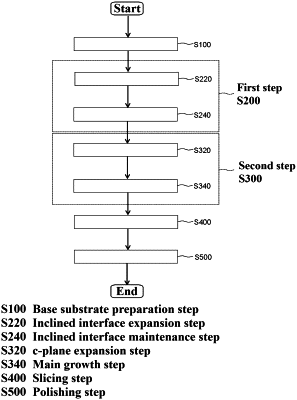| CPC C30B 25/186 (2013.01) [C30B 25/183 (2013.01); C30B 29/406 (2013.01); C30B 29/68 (2013.01); H01L 29/045 (2013.01); H01L 29/2003 (2013.01); H01L 29/872 (2013.01)] | 20 Claims |

|
1. A method for manufacturing a nitride semiconductor substrate using a vapor deposition method, including:
a step of preparing a base substrate comprising a single crystal of a group III nitride semiconductor, and having a mirror main surface whose closest low index plane is a (0001) plane;
a first step of epitaxially growing a single crystal of a group III nitride semiconductor having a top surface with (0001) plane exposed, directly on the main surface of the base substrate, forming a plurality of concaves composed of inclined interfaces other than the (0001) plane on the top surface, gradually expanding the inclined interfaces toward an upper side of the main surface of the base substrate, making the (0001) plane disappear from the top surface, and growing a first layer whose surface is composed only of the inclined interfaces; and
a second step of epitaxially growing a single crystal of a group III nitride semiconductor on the first layer, making the inclined interfaces disappear, and growing a second layer having a mirror surface,
wherein in the first step, a plurality of valleys and a plurality of tops are formed on a surface of the first layer by forming the plurality of concaves on the top surface comprising a single crystal and making the (0001) plane disappear, and
when observing an arbitrary cross section perpendicular to the main surface,
an average distance between a pair of tops separated in a direction along the main surface is more than 100 μm, the pair of tops being closest to each other among the plurality of tops, with one of the plurality of valleys sandwiched between them.
|